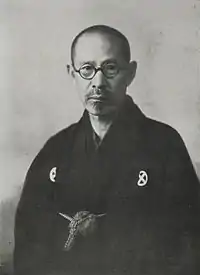Harumichi Tanabe
Harumichi Tanabe (田辺 治通, Tanabe Harumichi, 17 October 1879 – 30 January 1950) was a bureaucrat and cabinet minister in early Shōwa period Japan.
Harumichi Tanabe 田辺治通 | |
|---|---|
 Harumichi Tanabe in 1953 | |
| Born | 17 October 1879 Kōshū, Yamanashi, Japan |
| Died | 30 January 1950 (aged 70) |
| Nationality | Japanese |
| Alma mater | Tokyo Imperial University |
| Occupation | Bureaucrat, Cabinet Minister |
Biography
Tanabe was born in what is now Kōshū, Yamanashi as the younger son of a local sake brewer. He graduated from the law school of Tokyo Imperial University in 1905 and received a posting to the Ministry of Communications. He was subsequently sent to France for studies, and returned as an expert in wireless communications. Tanabe rose through the ranks within the ministry, becoming Bureau Chief in 1924.
Tanabe was drawn into politics over the debate for constitutional revision at the time of the Kiyoura administration, and denounced the privileged position of the bureaucracy. He resigned from his post at the time of the Katō administration.
However, conservative Minister of Justice and President of the House of Peers, Kiichirō Hiranuma thought very highly of Tanabe, and invited him to accept a position on the board of his Kokuhonsha, a nationalist political group founded in 1924.[1] Tanabe became Hiranuma’s protégé and assistant. In 1927, he was appointed Governor of Osaka by Home Minister Suzuki Kisaburō, another Hiranuma protégé and Kokuhonsha member. However, he was forced to resign after a year when Suzuki was indicted on suspicion of electoral irregularities.
In 1933, Tanabe relocated to Manchukuo, where he served as vice-chairman to the Privy Council of the Empire of Manchukuo. He supported the viewpoint of the Kwangtung Army that private management of industries was more realistic than a completely state-controlled economy.[2] He was recalled to Japan with the formation of the Hiranuma administration, and after serving for a brief period as Chief Cabinet Secretary from January to April 1939, he was appointed Minister of Communications, serving in that post from April through the end of August 1939.[3]
In 1938, Tanabe was appointed to a seat in the Upper House of the Diet of Japan. In 1941, he succeeded his mentor Hiranuma in the post of Home Minister in the 3rd Konoe administration for a period of three months.
After World War II, Tanabe was purged by the American occupation authorities. He died of illness in 1950.
References
- Hall, John Whitney. The Cambridge History of Modern Japan. Cambridge University Press (1988). ISBN 0521223571
- Hunter, Janet. A Concise Dictionary of Modern Japanese History. University of California Press. (1984). ISBN 0520043901
- Yamamura, Kozo. The Economic Emergency of Modern Japan . Cambridge University Press (1997). ISBN 0521589460
- Yagami, Kazuno. Konoe Fumimaro and the Failure of Peace in Japan, 1937–1941. Mcfarland (2006). ISBN 0786422424
- Yang, Daqing. Technology of Empire: Telecommunications and Japanese Expansion in Asia. Harvard University Press (2010). ISBN 0674010914
External links
| Wikimedia Commons has media related to Harumichi Tanabe. |
Notes
- Bix. Hirohito and the Making of Modern Japan. p. 164.
- Yang. Technology of Empire. p. 92.
- Hunter. A Concise Dictionary of Modern Japanese History. p. 287.
| Political offices | ||
|---|---|---|
| Preceded by Akira Kazami |
Chief Cabinet Secretary 5 January 1939 – 7 April 1939 |
Succeeded by Kōzō Ōta |
| Preceded by Suehiko Shiono |
Minister of Communications 7 April 1939 – 30 August 1939 |
Succeeded by Ryūtarō Nagai |
| Preceded by Kiichirō Hiranuma |
Home Minister 18 July 1941 – 18 October 1941 |
Succeeded by Hideki Tojo |